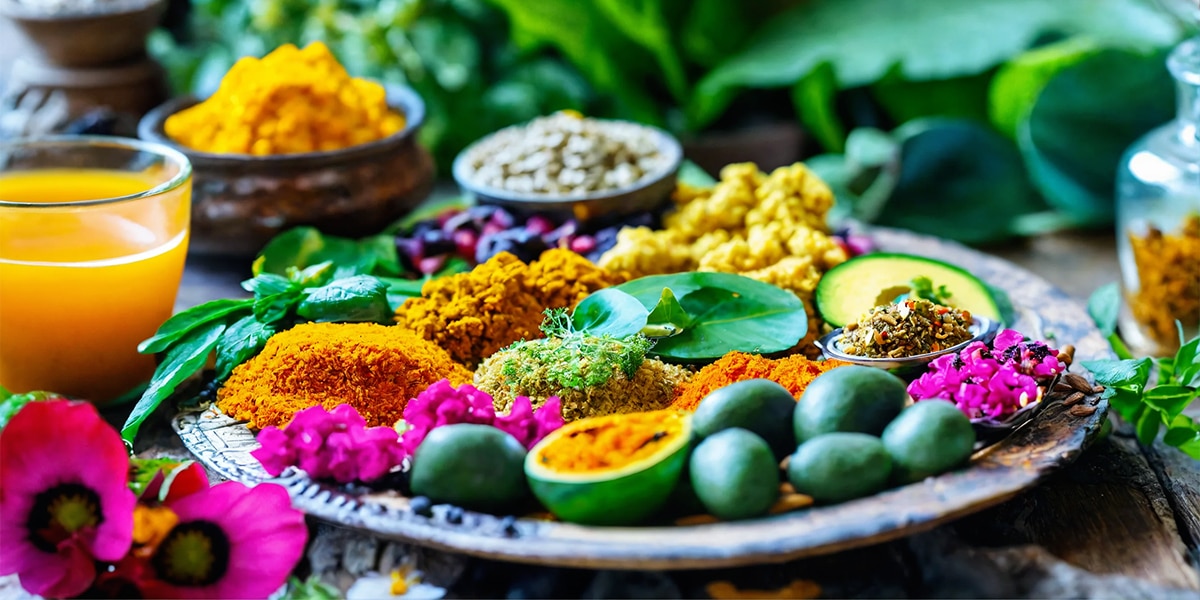In today’s world, diabetes has emerged as a significant health concern, affecting millions globally. Among the various approaches to managing this condition, diet plays a pivotal role. The Ayurvedic diet, with its centuries-old wisdom, offers a unique perspective on achieving harmony and balance in life, making it an intriguing option for those battling diabetes.
This guide delves into the art of tailoring your meals to not only manage diabetes effectively but also to enhance overall well-being.
Understanding Ayurveda and Diabetes
Ayurveda, an ancient Indian system of medicine, views health as a delicate balance between the body, mind, and spirit. According to Ayurveda, diabetes results from an imbalance in the Kapha dosha, which is responsible for the body’s structure and fluid balance. The Ayurvedic approach to managing diabetes focuses on dietary adjustments, lifestyle changes, and herbal remedies to restore balance and promote the body’s natural healing ability.
Key Components of the Ayurvedic Diet for Diabetes
The Ayurvedic diet for diabetes emphasizes whole, unprocessed foods, seasonal fruits and vegetables, legumes, and whole grains. It encourages the inclusion of spices like turmeric, cumin, and fenugreek, known for their blood sugar-regulating properties. A critical aspect of this diet is mindful eating—paying attention to the taste, texture, and aroma of food, which aids in digestion and satisfaction.
Benefits of an Ayurvedic Diet in Diabetes Management
Adopting an Ayurvedic diet offers multiple benefits for diabetes management, including:
- Stabilized Blood Sugar Levels: By focusing on low-GI foods, the Ayurvedic diet helps in maintaining consistent blood glucose levels.
- Enhanced Digestive Health: Ayurvedic dietary principles improve digestion and metabolism, aiding in the efficient processing of nutrients.
- Reduced Risk of Complications: A balanced diet rich in antioxidants and anti-inflammatory foods can minimize the risk of diabetes-related complications.
- Holistic Well-being: Beyond physical health, the Ayurvedic diet promotes mental and emotional balance, contributing to overall quality of life.
Practical Tips for Implementing an Ayurvedic Diet
Implementing an Ayurvedic diet into your daily routine can seem daunting at first, but with practical tips and guidance, it can become an enjoyable and enriching experience. An Ayurvedic diet focuses on balancing the body’s doshas (Vata, Pitta, and Kapha) through the right choice of foods, mindful eating practices, and an understanding of one’s unique constitutional needs. Here are some practical tips to help you seamlessly integrate the principles of an Ayurvedic diet into your lifestyle.
Know Your Dosha
The first step in adopting an Ayurvedic diet is to understand your dominant dosha and its influence on your health and well-being. Each dosha has specific dietary recommendations to maintain balance and promote vitality. You can determine your dosha by consulting with an Ayurvedic practitioner or taking reliable online quizzes.
Eat Seasonally and Locally
Ayurveda emphasizes the importance of eating foods that are in season and locally sourced. Seasonal foods are more likely to be fresh, full of prana (life force), and naturally aligned with the body’s nutritional needs at different times of the year. Eating locally supports digestion and assimilation while reducing the environmental impact of your diet.
Focus on Whole Foods
Incorporate a diet rich in whole foods—fruits, vegetables, grains, legumes, nuts, and seeds. These foods are considered sattvic, promoting clarity, happiness, and health. They are naturally high in nutrients and fiber, supporting digestion and providing sustained energy.
Incorporate the Six Tastes
Ayurveda identifies six tastes—sweet, sour, salty, bitter, pungent, and astringent—each of which plays a critical role in balancing the doshas. Aim to include all six tastes in your daily diet to ensure nutritional balance, satisfy all taste receptors, and prevent cravings.
Practice Mindful Eating
Mindfulness is a key component of an Ayurvedic diet. Eat in a calm environment, focus on your food, chew thoroughly, and listen to your body’s hunger and fullness cues. Mindful eating supports digestion, enhances the enjoyment of meals, and helps prevent overeating.
Cook with Ayurvedic Spices
Spices are not only flavor enhancers but also powerful aids in digestion and metabolism according to Ayurveda. Incorporate spices like turmeric, cumin, coriander, fennel, ginger, and black pepper into your cooking. These spices can stimulate digestion, detoxify the body, and enhance the absorption of nutrients.
Establish a Routine
Ayurveda values the regularity of meal times, advocating for a substantial breakfast, a hearty lunch when the digestive fire is strongest, and a lighter dinner. Establishing a consistent eating routine supports the body’s natural rhythms, aids in digestion, and maintains energy levels.
Stay Hydrated with Warm Beverages
Drinking warm water or herbal teas throughout the day is recommended in Ayurveda to aid digestion and detoxification. Warm beverages can stimulate digestion, support toxin removal, and keep the body hydrated.
Listen to Your Body
Finally, listen to your body and adjust your diet as needed. Ayurveda is not one-size-fits-all, and what works for one person may not work for another. Pay attention to how different foods affect your energy, digestion, and overall well-being, and be willing to make changes as necessary.
Implementing an Ayurvedic diet is about more than just food choices; it’s a holistic approach to living that encourages balance, mindfulness, and harmony with nature. By following these practical tips, you can embark on a journey to improved health and vitality, deeply rooted in the ancient wisdom of Ayurveda.
| Food Item | Ayurvedic Properties | Benefits for Diabetes |
|---|---|---|
| Fenugreek (Methi) | Bitter, heating | Improves digestion, reduces blood sugar levels |
| Barley (Jau) | Cooling, dry | Helps control blood sugar, aids in weight management |
| Bitter Gourd (Karela) | Bitter, purifying | Regulates blood sugar, detoxifies the blood |
| Turmeric (Haldi) | Heating, anti-inflammatory | Reduces insulin resistance, fights inflammation |
| Cinnamon (Dalchini) | Sweet, heating | Enhances insulin sensitivity, lowers blood sugar levels |
Embracing Mindful Eating in Ayurveda
Incorporating an Ayurvedic diet into your life extends beyond the mere selection of foods; it invites you to engage deeply with the act of eating itself. Ayurveda places a strong emphasis on mindful eating, a practice that nurtures a profound connection between the body, mind, and nourishment. This ancient wisdom teaches us to listen attentively to our body’s cues, eating when truly hungry and stopping when just satisfied, thus preventing overindulgence and supporting digestion.
Creating a peaceful environment dedicated to eating, devoid of distractions, allows you to fully immerse in the meal, enhancing the digestive process and enabling you to savor each flavor and texture. The practice of chewing food thoroughly, aiming for 20-30 chews per bite, is another pillar of mindful eating, aiding in the breakdown of food and signaling the body to begin digestion. This not only improves nutrient absorption but also emphasizes the importance of being present and attentive with each bite.
Ayurveda encourages the inclusion of all six tastes — sweet, sour, salty, bitter, pungent, and astringent — in every meal to ensure a nutritional balance and meet the body’s diverse dietary needs. This holistic approach helps minimize cravings and instills a feeling of contentment with meals. Before beginning to eat, taking a moment to express gratitude for the food serves to center the mind, preparing the body for nourishment and acknowledging the life-sustaining nourishment provided.
Eating at consistent times each day, particularly with the largest meal at midday when the digestive fire is at its peak, aligns with the body’s natural rhythms, fostering optimal digestion and steady energy levels. Additionally, adapting your diet to the rhythm of the seasons by choosing foods that naturally grow during specific times of the year can further enhance the diet’s alignment with your body’s needs, offering suitable nourishment to balance the doshas.
Through mindful eating, each meal becomes a deliberate act of nourishment and reflection, transforming the simple act of eating into an enriching experience that feeds not just the body, but also the soul. This practice is a testament to Ayurveda’s comprehensive approach to health, emphasizing that how we eat is just as crucial as what we eat. By embracing these principles, you can elevate your Ayurvedic diet, weaving together a tapestry of dietary choices that support not only physical health but also a deeper, more harmonious state of being.
Ayurvedic Diet for Diabetes Harmony: Your FAQs Answered
What is the Ayurvedic perspective on diabetes?
Ayurveda views diabetes as a disorder of the Kapha dosha, characterized by an imbalance that leads to excessive sugar in the blood. It recommends a holistic approach involving diet, lifestyle adjustments, and herbal remedies to restore balance and enhance the body’s natural healing processes.
Can Ayurvedic diet alone control diabetes?
While an Ayurvedic diet plays a crucial role in managing diabetes by regulating blood sugar levels and improving metabolism, it should be part of a comprehensive approach that includes regular exercise, stress management, and medication as prescribed by healthcare professionals.
What foods should I avoid in an Ayurvedic diet for diabetes?
It’s advisable to avoid or limit foods that are high in simple sugars, processed carbohydrates, and unhealthy fats. These include sweetened beverages, white bread, pastries, and fried or fast foods that can disrupt blood sugar levels.
Are there specific Ayurvedic herbs beneficial for diabetes management?
Yes, herbs like turmeric, fenugreek, cinnamon, and bitter gourd are known for their blood sugar-lowering properties. However, they should be used under the guidance of an Ayurvedic practitioner as part of a balanced diet.
How important is meal timing in an Ayurvedic diet for diabetes?
Meal timing is significant in Ayurveda, which suggests eating a substantial breakfast, a hearty lunch when the digestive fire is strongest, and a lighter dinner. This pattern supports natural body rhythms and aids in better digestion and blood sugar control.
Can I follow an Ayurvedic diet if I'm on insulin or other diabetes medications?
Yes, but it’s important to consult with your healthcare provider. Adjustments to your diet can affect blood sugar levels and may require modifications to your medication doses.
What role does digestion play in managing diabetes according to Ayurveda?
Ayurveda emphasizes strong digestion, or Agni, as key to overall health. A well-functioning digestive system ensures efficient nutrient absorption and elimination of toxins, both crucial for maintaining stable blood sugar levels.
Is it necessary to customize the Ayurvedic diet according to my dosha type?
Customizing your diet according to your dominant dosha can enhance the diet’s effectiveness in balancing your body’s specific needs. Consulting with an Ayurvedic practitioner can provide insights into your dosha type and dietary recommendations.
How does an Ayurvedic diet differ from a conventional diabetic diet?
While both diets aim to stabilize blood sugar levels, an Ayurvedic diet places greater emphasis on whole foods, mindful eating, balancing the six tastes, and aligning with one’s dosha for holistic well-being, beyond just managing diabetes.
Where can I find reliable resources or professionals to help me start an Ayurvedic diet for diabetes?
Consider consulting certified Ayurvedic practitioners or visiting reputable Ayurvedic centers. Resources such as the National Ayurvedic Medical Association (NAMA) in the U.S. can provide directories of professionals. Additionally, books by well-respected Ayurvedic authors and scholars, as well as peer-reviewed journals on Ayurvedic medicine, offer valuable information.
Citations
- “Cinnamon use in type 2 diabetes: an updated systematic review and meta-analysis” – Annals of Family Medicine, September/October 2013. This meta-analysis examines the role of cinnamon, frequently used in Ayurvedic dietary practices, in managing type 2 diabetes, highlighting its potential to lower fasting blood glucose levels.
- “Curcumin and Diabetes: A Systematic Review” – Evidence-Based Complementary and Alternative Medicine, 2013. This review explores the effects of curcumin, the active ingredient in turmeric, on diabetes management, including its anti-inflammatory and antioxidant properties that benefit insulin sensitivity and blood glucose levels.
- “Dietary and nutritional approaches for prevention and management of type 2 diabetes” – BMJ, June 2018. While not exclusively focused on Ayurveda, this comprehensive review provides evidence on the importance of dietary and nutritional strategies in preventing and managing type 2 diabetes, aligning with the Ayurvedic emphasis on diet for health.






